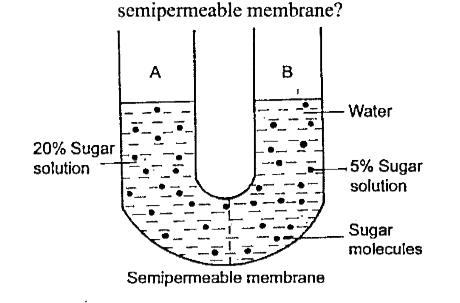Why is plasma membrane said to be semipermeable ?
Step-by-Step Solution
1. Definition of Plasma Membrane: The plasma membrane, also known as the cell membrane, is a biological membrane that separates and protects the interior of the cell from the external environment.
2. Structure of Plasma Membrane: The plasma membrane is primarily composed of a lipid bilayer, which consists of two layers of phospholipids. This bilayer is embedded with various proteins, including integral proteins and peripheral proteins.
3. Understanding Semipermeability: The term "semipermeable" refers to the ability of the plasma membrane to selectively allow certain substances to pass through while restricting others. This means that not all molecules can freely enter or exit the cell.
4. Selective Permeability: The plasma membrane is selectively permeable, meaning it permits the passage of specific molecules based on size, charge, and polarity. For instance, it allows small hydrophobic (nonpolar) molecules to pass through easily.
5. Molecules Allowed to Pass:
- Hydrophobic Molecules: These can move freely through the lipid bilayer because they are compatible with the lipid nature of the membrane.
- Small Polar Molecules: Small polar molecules can also diffuse through the lipid bilayer, albeit less easily than hydrophobic molecules.
6. Molecules Restricted from Passing:
- Ions: Charged particles cannot pass through the lipid bilayer due to their charge.
- Large Polar Molecules: These molecules are also unable to pass through the membrane without assistance.
7. Transport Mechanisms for Restricted Molecules: Molecules that cannot pass through the plasma membrane by simple diffusion require alternative methods such as:
- Facilitated Transport: This involves carrier proteins that help transport substances across the membrane.
- Active Transport: This process requires energy to move substances against their concentration gradient.
8. Conclusion: The plasma membrane is termed semipermeable because it selectively allows certain molecules to enter or exit the cell while preventing others, thus maintaining the cell's internal environment.
- Hydrophobic Molecules: These can move freely through the lipid bilayer because they are compatible with the lipid nature of the membrane.
- Small Polar Molecules: Small polar molecules can also diffuse through the lipid bilayer, albeit less easily than hydrophobic molecules.
- Ions: Charged particles cannot pass through the lipid bilayer due to their charge.
- Large Polar Molecules: These molecules are also unable to pass through the membrane without assistance.
- Facilitated Transport: This involves carrier proteins that help transport substances across the membrane.
- Active Transport: This process requires energy to move substances against their concentration gradient.
Topper's Solved these Questions
- CELL - THE UNIT OF LIFEBOOK - ICSECHAPTER - CELL - THE UNIT OF LIFEEXERCISE - REVIEW QUESTIONS (SHORT ANSWER TYPE QUESTIONS)
22 Videos
- CELL - THE UNIT OF LIFEBOOK - ICSECHAPTER - CELL - THE UNIT OF LIFEEXERCISE - REVIEW QUESTIONS (LONG ANSWER TYPE QUESTIONS)
14 Videos
- CELL - THE UNIT OF LIFEBOOK - ICSECHAPTER - CELL - THE UNIT OF LIFEEXERCISE - REVIEW QUESTIONS (GIVE ONE WORD FOR THE FOLLOWING)
5 Videos
- BREATHING AND EXCHANGE OF GASESBOOK - ICSECHAPTER - BREATHING AND EXCHANGE OF GASESEXERCISE - REVIEW QUESTIONS (LONG ANSWER TYPE QUESTIONS)
8 Videos
- CELL : THE UNIT OF LIFE BOOK - ICSECHAPTER - CELL : THE UNIT OF LIFE EXERCISE - Differentiate Between
18 Videos
Similar Questions
Knowledge Check
Plasma membrane helps in
AosmoregulationBprotein synthesisCnucleic acid synthesisDtransportation of only water in and out of cell
Plasma membrane is made of
View SolutionPlasma membrane is made of
View SolutionThe plasma membrane is more permeable to
View SolutionPlasma membrane is semipermeable as_________
View SolutionPlasma membrane controls
View SolutionWhy is the plasma membrane called a selectively permeable membrane
View SolutionStudy the set-up given in the diagram and answer the following questions:

Why is the membrane called semipermeable membrane?
View Solution
